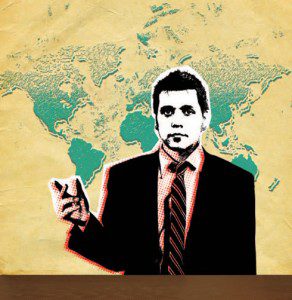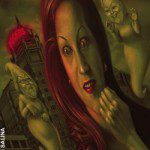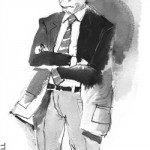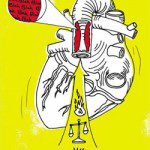The Case for George
To the surprise of many, Strombo is still on the air. Sometimes he even has depth
Eight thirty p.m.: the crunching sound of a key working a lock. George Stroumboulopoulos opens the door to his Queen West home in Toronto and throws his keys on the coffee table. He sits down with a plate of pasta to watch the Canadiens game. He’s reading The Guardian online when Jennifer Dettman, executive producer of The Hour, makes her nightly call to talk about tomorrow’s show, right about the same time Peter Mansbridge begins reading The National.
Dettman’s calling to discuss Second Life. The Hour’s crew has been working on a story about the online universe for a few weeks now. It’s a bizarre phenomenon: more than a million people plug in to a digital world not dramatically different from our own and spend a combined $1.5 million there every day. American Apparel has a store inside, Reuters has a news bureau. Tomorrow, The Hour has an interview with Julian Dibbell, a magazine writer who quit his job to live in the fantasy world full time. It looks like a slow news day tomorrow and Dibbell is available, so they’ll go with the piece. George hangs up the phone by midnight, making the work-related part of his day about 15 hours. “This isn’t a job,” he says. “It’s a life.” George heads to his computer to poke around online, eventually falling asleep listening to The Ricky Gervais Show podcast, the voice of the British comedian ringing in his ears.
To some extent CBC has always been free from the usual constraints of for-profit television. But in the current multi-channel universe, it must regularly produce intelligent Canadian programming in order to justify its existence. For the past decade it has been constantly reinventing itself, offering creative vehicles it hopes Canadians actually enjoy. Like Jian Ghomeshi’s >play and Big Life with Daniel Richler before it, The Hour is CBC’s attempt to balance current affairs with entertainment value for a mass audience. So far the mix has been unbalanced, often showcasing neither effectively.
At the heart of this latest experiment is The Hour’s frenetic, black-clad host with the exceptionally long surname, George Stroumboulopoulos (or just George). The program drew immediate and heavy criticism for dumbing down the news in order to reach younger viewers, but then George isn’t trying to be a youth-friendly Peter Mansbridge. Nor is he trying to be a pundit, an academic or a politician – or a journalist, for that matter. George is just some guy who likes his music, sports and politics mixed together in one fast, long conversation. The Hour gives that guy the chance to speak with the newsmakers of the day and interpret the news his own way. Given the roasting George has received so far, it’s suprising to see that – every so often – he delivers an original kind of television product. What is a little more difficult to calculate is whether or not it’s news programming or infotainment.
George strolls into CBC a little after nine, with four hours sleep under his belt, black-waxed hair, sad dog eyes and friendly as hell. In the echo of hard-soled shoes parading the halls, his Adidas are almost silent. He’s in standard uniform today: jeans, silver-studded belt, black shirt. The only variable is the type of black shirt. Today, it’s a button-up, no branding. He crosses the foyer on his way to The Hour’s ground floor offices but detours when he sees people lined up for The Gill Deacon Show. He works the crowd, shaking hands, looking people in the eye and giving the distinct impression he cares about what they tell him. After a few minutes, he heads for the office’s back entrance where producers Dettman, Susan Taylor and Dave Freeman wait for him. It’s usually a bigger crowd, but this is a slow news day, so the writers and segment producers are off finishing pieces they’ve had in the works for a while. George takes his seat, gets updated and gets down to work.
George was raised in the Rexdale and Malton areas of suburban Toronto by his mother, Mary Ivanyshan, a Ukrainian immigrant, and a close extended family. “It was old-school immigrant, the village raises the kid,” says George, now 34 years old. “It was always fun. My house was always filled with love.” When his father – a Greek who emigrated from Cairo – left home, Uncle Paul filled in as male role model. In high school, George was a terrible student and was saved by a charitable drama teacher who let him come to class on the days he was suspended so he wouldn’t fall behind. Other than drama, his extracurricular career was limited to curling. He liked gliding across rinks, competing against the upper crust, clad in black.
George began his already lengthy media career in radio. From Humber College’s radio broadcast program he landed jobs at Toronto’s Fan 590 in 1993 and then 102.1 The Edge in 1997. Spider Jones, who hosted the Fan’s overnight show, remembers meeting some young punk with a ponytail, his new sound engineer. “George had the earrings, he was the new generation,” Jones says. “Nobody took him seriously because they didn’t get a chance to know him.” But George was a hard worker and knew his sports, so when a producer’s spot opened on Jones’s show, he surprised his colleagues by giving the gig to the weird new guy. And George took every shift he could get. On Friday evenings he’d do Jones’s show, then work straight through the weekend. By Sunday morning, he’d be asleep in the on-air booth when a voice would come on over his headphones: “You’re on in five.” He’d wake up, jog around the office and sit back at the mic to give the sports update before falling back asleep again.
After seven years in radio, George moved to MuchMusic in 2000. He hosted The Punk Show, MuchLOUD and MuchNews. He also jumped at the chance to do The New Music, traditionally considered one of the few bright spots in Canadian music broadcast journalism, and a show that graduated respected journalists Daniel Richler, John Roberts and Avi Lewis. By the time George arrived, though, Much had moved closer to the MTV model, dedicating more airtime to fan culture and less to the journalistic analysis found on The New Music. However, during this period George’s reporting occasionally became overtly political. In 2002, he filmed a documentary in Zambia, a joint project between Much and the humanitarian agency CARE Canada, about the impact of aids in Africa. He followed that up in 2004 with a documentary in Sudan about the Darfur conflict.
The same year, Much assigned George to host Fandemonium, a cheap Fear Factor knockoff where viewers humiliated themselves to prove their devotion to a particular band. The first episode climaxed with contestants changing a doll’s diaper, complete with real baby shit. At the end of the show, the host presented the winner with a choice: a home entertainment system or one of two mystery boxes, one of which contained an invite to a weekend trip to blink-182’s hometown. “Or, you can go through the whole day of dangerous, vomitous, ridiculous, asinine challenges and then walk out with a box of dog biscuits.”
George started to think about quitting that day. The move would be gutsy – at Much he gave the impression he was the smartest guy in the room, but CBC would be a different world, with a different audience.
A year after Heaton Dyer took over as CBC Newsworld’s director of programming in 2003, he told Dettman to try something new. The format was almost entirely open – develop a new prime-time talk show for Newsworld. Throughout the development phase, one very long name came up: George Stroumboulopoulos. Dettman and Dyer met their prospect that fall, about a month after he filmed CBC’s The Greatest Canadian. George wasn’t moved. He thought CBC would pull the reins on him and he didn’t think he’d fit in – his better judgement told him to stay away. Then, a week or so later he got a call from his manager, Michael Sugar. Dettman and Dyer weren’t going away, Sugar told him. You can keep your clothes, your piercings and your attitude – that’s what they want. You should meet them again. George finally decided to leave Much in fall 2004. He told Sugar in a text message while waiting at Pearson International Airport for a flight to Sudan. When he got back to Toronto he phoned his boss at Much and slowly started telling his co-workers that he was leaving to do a show on the CBC – does anyone want to come? He won one convert that day, segment producer Darby Wheeler (now a VJ on The Hour).
At first, CBC created The Hour to give Newsworld a flagship interview show that would bring people back to the channel every night at 8 p.m. Part of what informed this plan was a massive study done by CBC that told the network they had to broaden their definition of the news. “I’d been thinking about this notion of the news anchor as Voice of God, as the person who knows everything,” Dettman says. “I thought, ‘Wouldn’t it be great to create a show with a guy who has an opinion, just like you and me?'” During the next few months, George, Dettman and producer Susan Taylor set about turning their regular guy with an opinion into the news.
George bought into Dettman’s concept and CBC’s willingness to take a risk. “No one has the fucking balls to put a guy like me on the air and let me steer a show the way they do,” he says. “And to do the subject matter. And to let Jen have as much control as she has. And to let me have as much control as I have.”
If you were standing behind George while he’s on camera, you’d be able to follow what he’s saying on the teleprompter for a few seconds. Before long, though, he’ll veer off on his own. The prompter will then stop, jump in one direction, then another, trying to figure out where George has gone. This makes scriptwriting for The Hour a strange process.
By the time George gets to the boardroom at 9:30 a.m., the office has been buzzing for at least an hour. His staff has gone through the day’s news and pitched various stories and approaches. The first thing the host does is give his thumbs up or thumbs down. Then he pitches his own ideas. Once everything’s decided, they all sit down to write the day’s script. Because of George’s delivery, it mostly fills in the bullet points and punch lines. At about 10:30 a.m. the meeting disperses and people head to the archives, editing suites and computers to prepare the various segments. George drifts between everyone to see how things are coming, researches for interviews and calls audience members to confirm tickets.
In October 2006, when The Hour premiered on CBC’s main network and took over the 11 p.m. spot from The National recap, it gained a live studio audience. Since it shoots live to tape (filming in exactly the same running time as on TV, commercials included), George gets a lot of face time with the audience. When the show breaks for commercials the monitors go to black, the crew goes about their quieter tasks and an awkward silence falls over the set. Today, George chats with the audience to fill the gap, giving them a little insight into what he’s doing. “This is kind of new to TV,” he says. “When politicians come on, they look at me – and when I say me, I mean you – and they don’t think we have a right to be in on this. But fuck off, we do. I don’t look like people on television, but I look like you.”
Dettman and just about everyone who works at The Hour will tell you that the show was never intended to reach young people so much as people of a certain mindset: the host’s. But despite how often they say it, no one seems convinced. The truth is, only about four per cent of The Hour’s viewers are under the age of 18. About two-thirds are between 18 and 49, and the remaining third is over 50. On an average night, The Hour pulls in about 125,000 viewers after The National, which hooks about 600,000 in the 10 p.m. timeslot. To put this into perspective, CTV News, also on at 11 p.m., brings in about 930,000. Further up the dial on the Comedy Network, The Daily Show and The Colbert Report come in a little closer to The Hour’s numbers, at about 158,000 combined.
If you dissect The Hour you’ll find pieces of other shows: Conan O’Brien, The Daily Show, Entertainment Tonight, >play and, of course, The National. Some nights it ends there, simply splicing bits together, retelling them in the host’s voice. But on other nights George produces something original. The Hour is at its best when it makes connections across genres. George will talk to Ludacris about the differences between reflecting ghetto reality to suburban kids in rap and in film, or to Terry Gilliam about the semantics of the term “Aboriginal,” or to Kenny and Spenny about societal trends of cheering for the bad guy. George recognizes this restless jumping around as the show’s strength. “How do you describe it? I don’t know,” he says. “To talk to Gerard Kennedy on the same night that we talk to Jack Black, or Billy Connolly on the same night we had Muhammad Yunus. What I like about it is the audience has just come to realize that’s just The Hour.”
The show falters most when it stays focused, because that’s when it becomes predictably journalistic. George isn’t specialized – he’s not the sports guy when he talks to hockey players or the movie guy when he talks to actors. What saves the show on any given night is the fact that George isn’t a journalist, but a quirky – albeit thuggish – Everyman.
Early in the season, George lands an interview with Michael Ignatieff, then a Liberal Party leadership candidate, now deputy leader. Ignatieff had fumbled badly when talking about the Israel-Lebanon conflict during the summer, managing to offend both sides. Then, one week prior to taping The Hour, his campaign co-chair and Liberal MP Susan Kadis walked out on him when he refused to clarify his position. Ignatieff’s publicity appearance on The Hour is an opportunity for damage control.
“This has been a tough week for you and your campaign, hasn’t it?” George enquires.
“It’s been a week in which I’ve listened and learned,” Ignatieff responds. “So it’s been positive. But it’s been a week in which I made a decision to go to Israel. I made a decision to make sure that I learn how Canada can contribute. Because we need to understand that Canada can do a lot here. Israel, Palestine, Lebanon, we’ve been focused on this issue for many years – for 60, 70 years. We can make a contribution, I want to help.”
“But you had to listen and learn because you spoke. And you spoke twice and the things you said. Now, you said this thing – that you wouldn’ t lose sleep about the Lebanese, then you went and apologized…” Ignatieff cuts in: “Taken out of context. It has to be said, I’ve always called Qana a tragedy. From the beginning. I’ve been completely consistent about that.”
“But when you went on to apologize, or clarify the second time, you got into trouble again.” George sits up a bit. “Which, the interesting part was….”
Ignatieff cuts him off again, trying to control the interview, speaking slowly, punctuating his sentences with “uh” so it sounds like he’s not done speaking. “Well, understand what the clarification was about. Reports came out, from reputable human rights organizations saying that there had been violations of the laws of war on both sides. I’ve never hesitated to say that. Uh…”
“But you said it was a war crime by Israel is what you said the first time out.”
“No. No. What I said: Qana was a war crime. That makes it very clear that there were terrible things that happened at Qana, done by Hezbollah, against Israel, other actions by Israel which may have violated the laws of war. Now, there’s been reaction to that. I take those reactions seriously, I take those reactions respectfully, going to Israel to listen, learn. Talk to people.” George seems bored. Annoyed. “Figure out where we need to go forward.”
“Did you say Israel committed a war crime?”
“I said,” Ignatieff squirms. “The words I used were Qana was a war crime.”

“But if that’s the case then why did a key member of your group quit over this? Like, this was more than just, you know, Qana, this was a big deal and this person quit on you and that painted you in that light.”
Ignatieff says he respects Kadis’s decision and segues into outrage against Prime Minister Stephen Harper’s handling of the conflict with a quick, “We have to move forward here.”
George grilled Ignatieff long enough to make the interview worth watching. Weeks later, during one of The Hour’s silent commercial breaks, he reflects on the interview with bravado that might be attributed to the fawning questions of his audience. “Whenever a politician comes on I tell them, ‘You’ve come on here because you know we’ll be fair, but if you dodge my questions, if you make me look like a punk, I will fucking kill you.'”
The George you meet off-air isn’t much different from the one you see on TV: a friendly smartass with more confidence than he knows what to do with. His badass image is well advertised and encouraged by CBC. If it’s an act, it’s one he himself believes. While the image is laughable to his critics, it can also work to George’s advantage: no one expects him to be polite, so he can skip the subtler scalpels of interviewing and just start swinging the hatchet.
Not everyone buys George’s regular guy schtick. Shortly after The Hour launched, Globe and Mail television critic John Doyle called George a “kid doing a grown-up’s job. Grown-ups have to get it right, not just do it fast. Fast and flippant news isn’t cool. It’s condescending crap.” A lot of criticism also hinges on George’s interview technique. Shortly after the show premiered on the main network, the National Post’s Rob McKenzie wrote about his interview with Liberal MP Belinda Stronach. “He’s a good listener. Maybe too good. The Stronach interview became tedious as he let her rattle on about how, when it comes to the Liberal leadership convention, she’s a big believer in one member, one vote.”
Of all the criticism The Hour has attracted, Barrett Hooper’s November 2006 piece for Now magazine, in Toronto has to be the most negative. “Strombo, the sideburned, sleepy-eyed ex-VJ, is the over-hyped host of The Hour, a Daily Show-and Access Hollywood-inspired wankfest that sets out to answer such burning questions as ‘Are African babies the new Von Dutch trucker hat?’ It also unintentionally asks how much journalistic integrity the CBC will sacrifice to attract younger viewers.” Hooper is more forgiving in person, saying George is improving, but adds, “The soul patch, his black outfit, it’s like Mr. Rogers putting on his sweater-vest and his loafers are his sneakers – every night it’s the same thing.” Hooper says he’s not sure why, but his critique of The Hour inspired more reader feedback than anything he’d written in years. He suggests the program draws interest because it’s not what we expect. “Even if people at the CBC don’t quite understand what is hip and cool, they’re at least stepping outside the normal CBC box to try something.”
Tonight, when the The Hour ends, the audience and crew drain out of the room and leave the set and its surrealist stripper motif looking lifeless. The empty studio is cold, muted, like a bar after closing. The Hour is supposed to add a new dimension to the news. It rarely achieves this goal to much satisfaction, but there is the odd glimmer of its capabilities. The show needs time to mature – a luxury commercial networks wouldn’t have. But even if the public broadcaster nurses the show to adulthood, there’s no guarantee it would be worth it. If George continues to scratch at the surface of issues, he’ll end up on top of the stack of failed CBC experiments. But if he adds depth to his omnivorous approach to reporting on entertainment, culture and news, The Hour could work. George comes across as everyone’s regular guy, so the question is: When does a regular guy like George grow up? The Hour will only grow if he does.













